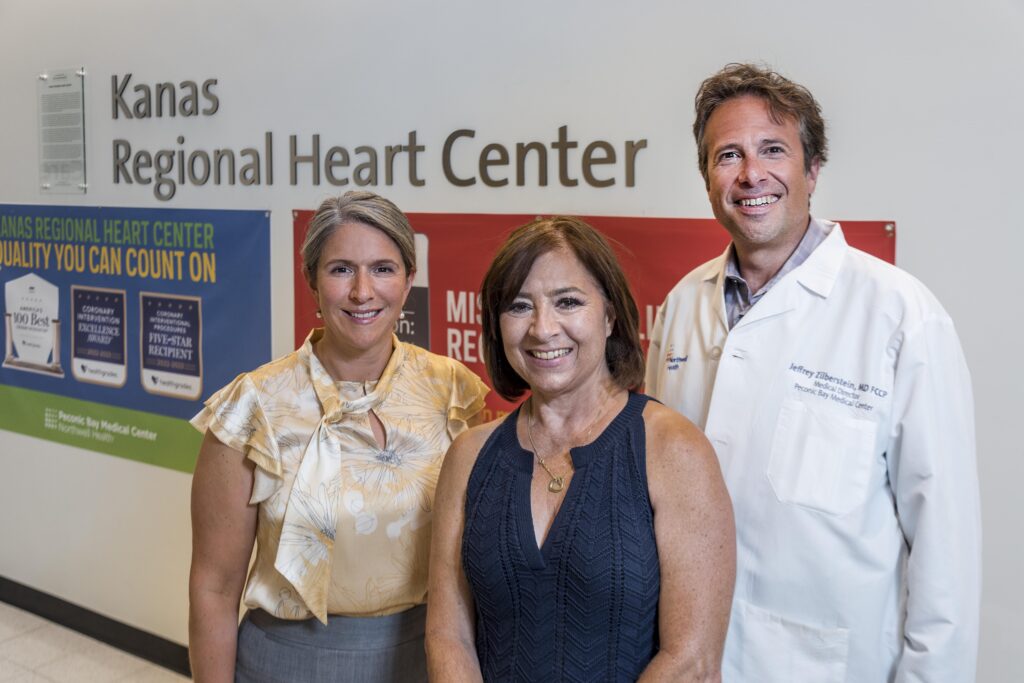Peconic Bay Medical Center’s new cardiac testing technology saves lives

When Natalie Crowe of Setauket went for her physical in April, she felt perfectly fine. The last thing she expected to hear was that there was an irregularity in her heart. Little did she know she was about to receive a new lease on life thanks to technology now available at Peconic Bay Medical Center.
“[Nurse practitioner Michelle Craddock] did a regular physical — first they did an EKG, and then she came in, examined me, talked to me. And then she said there’s a very small change in one of the waves on your EKG,” Ms. Crowe said. “And it’s very small, she said, but the machine spits out the message, you could have possibly had a heart attack … My jaw hit the ground.”
Ms. Craddock recommended that she see a cardiologist and Ms. Crowe turned to Dr. Stanley Katz, PBMC’s chairman of cardiology, who ordered imaging of her heart on one of the latest technological innovations available at the Kanas Regional Heart Center: the Siemens SOMATOM multiple-slice scanner. According to PBMC, the scanner provides 3D images for fast, non-invasive identification of blockages and other cardiac conditions. The result for Ms. Crowe was prevention of a potentially life-threatening heart attack.
Acquiring such state-of-the-art technology was a process for the hospital, according to executive director Amy Loeb, and required approval from New York State. The scanner itself cost PBMC $1.5 million and creating the space to house it cost $750,000, according to hospital officials. Funding was part of the hospital’s capital project plan for ongoing investments at PBMC.
“Dr. Katz brought the idea to us, recognizing that this is the latest innovation for cardiology, and advocated for the best machine that was available,” Ms. Loeb said.
The machine was ready for patient use at the hospital by June.
Ms. Crowe’s imaging took place June 21, and revealed that she had an 80% blockage in her heart’s left anterior descending artery.
According to Healthline, that artery transports a large amount of blood to the heart. A heart attack stemming from that artery is also known as a “widow maker,” due to low survival rate for those who suffer from it. The American Heart Association reports only 12% of those who suffer such heart attacks outside a hospital survive. The survival rate rises to 25% for those already hospitalized when an attack occurs.

The following day, Ms. Crowe saw Dr. Katz’s colleague, Dr. Andrew Persits, who performed a catheterization, inserting a stent that opened the blocked artery. During that procedure, they realized the artery was actually blocked up to 85%.
“I’m thinking to myself, I’m a perfectly fine person and I could have gone from this to that in a breath,” Ms. Crowe said. “It saved me, and it’s going to save other people.”
Ms. Loeb said the Siemens SOMATOM multiple-slice scanner is a tool that helps health care providers achieve their goal of preventing illness.
“It’s a prevention tool, and so from our standpoint, the most important thing we can do as health care providers is prevent illness or minimize the impact and so it has the capability to save lives for folks who have disease in their hearts,” Ms. Loeb said. “It’s a tool that tells us about medications that they should be taking, and it also gives many folks peace of mind that everything is okay. Either way, we have an awareness that we didn’t have before in an easy test and it’s a tremendous benefit to the community.”
Dr. Katz said this technology has revolutionized cardiac care. “The way we’ve seen it evolve is that it has replaced doing stress testing,” he said. “It’s so much more accurate than doing a stress test. When we opened, we had 140 patients waiting for the procedure, because up until early this year there was nothing on the East End.”
Ms. Crowe grew up in Baldwin and lived there for 28 years before moving to Setauket in 2020. She worked as an X-ray technician at South Nassau Hospital for over 11 years.
“You hear about the hospitals in the city —’You gotta go here for that’ — and St. Francis Hospital [and Heart Center] is all I ever heard, and I thought, you don’t have to go anywhere,” Ms. Crowe said. “This right here is the spot.”
Ms. Crowe is currently undergoing cardiac rehabilitation at the hospital, during which she exercises under the supervision of a physical therapist and nurse practitioner and receives nutritional guidance. She said she wants her story to encourage other community members to stay on top of their health.
“People really need to realize how important it is to go for your regular checkups and have your eyes and ears open on your health and follow through,” Ms. Crowe said. “Don’t put these things off — and follow the doctor’s instructions.”








